Page 2174 of 4592
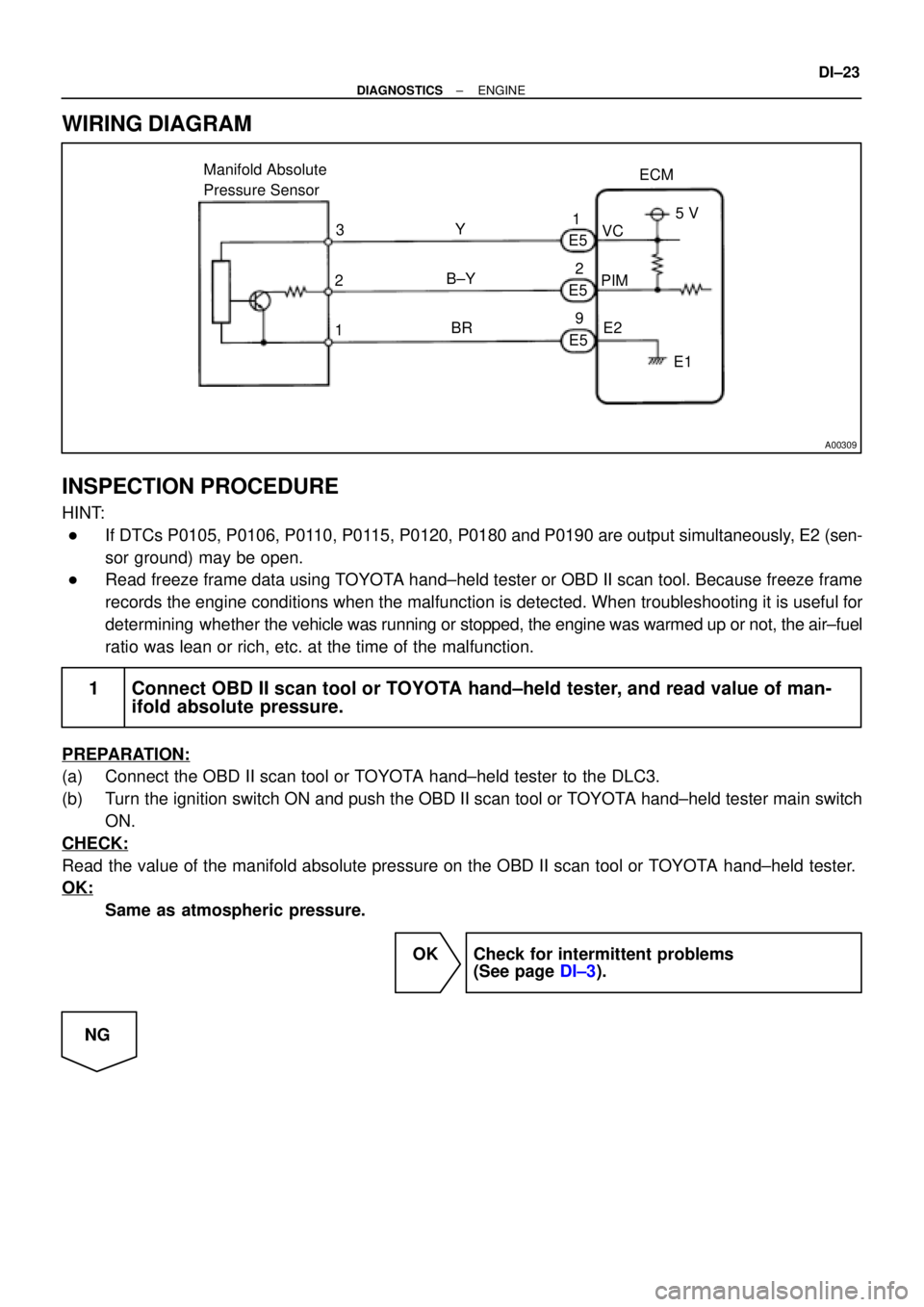
A00309
ECM Manifold Absolute
Pressure Sensor
1PIMVC
E2 Y
B±Y
BRE5
E5
E5 3
25 V
E1 1
2
9
± DIAGNOSTICSENGINE
DI±23
WIRING DIAGRAM
INSPECTION PROCEDURE
HINT:
�If DTCs P0105, P0106, P0110, P0115, P0120, P0180 and P0190 are output simultaneously, E2 (sen-
sor ground) may be open.
�Read freeze frame data using TOYOTA hand±held tester or OBD II scan tool. Because freeze frame
records the engine conditions when the malfunction is detected. When troubleshooting it is useful for
determining whether the vehicle was running or stopped, the engine was warmed up or not, the air±fuel
ratio was lean or rich, etc. at the time of the malfunction.
1 Connect OBD II scan tool or TOYOTA hand±held tester, and read value of man-
ifold absolute pressure.
PREPARATION:
(a) Connect the OBD II scan tool or TOYOTA hand±held tester to the DLC3.
(b) Turn the ignition switch ON and push the OBD II scan tool or TOYOTA hand±held tester main switch
ON.
CHECK:
Read the value of the manifold absolute pressure on the OBD II scan tool or TOYOTA hand±held tester.
OK:
Same as atmospheric pressure.
OK Check for intermittent problems
(See page DI±3).
NG
Page 2178 of 4592
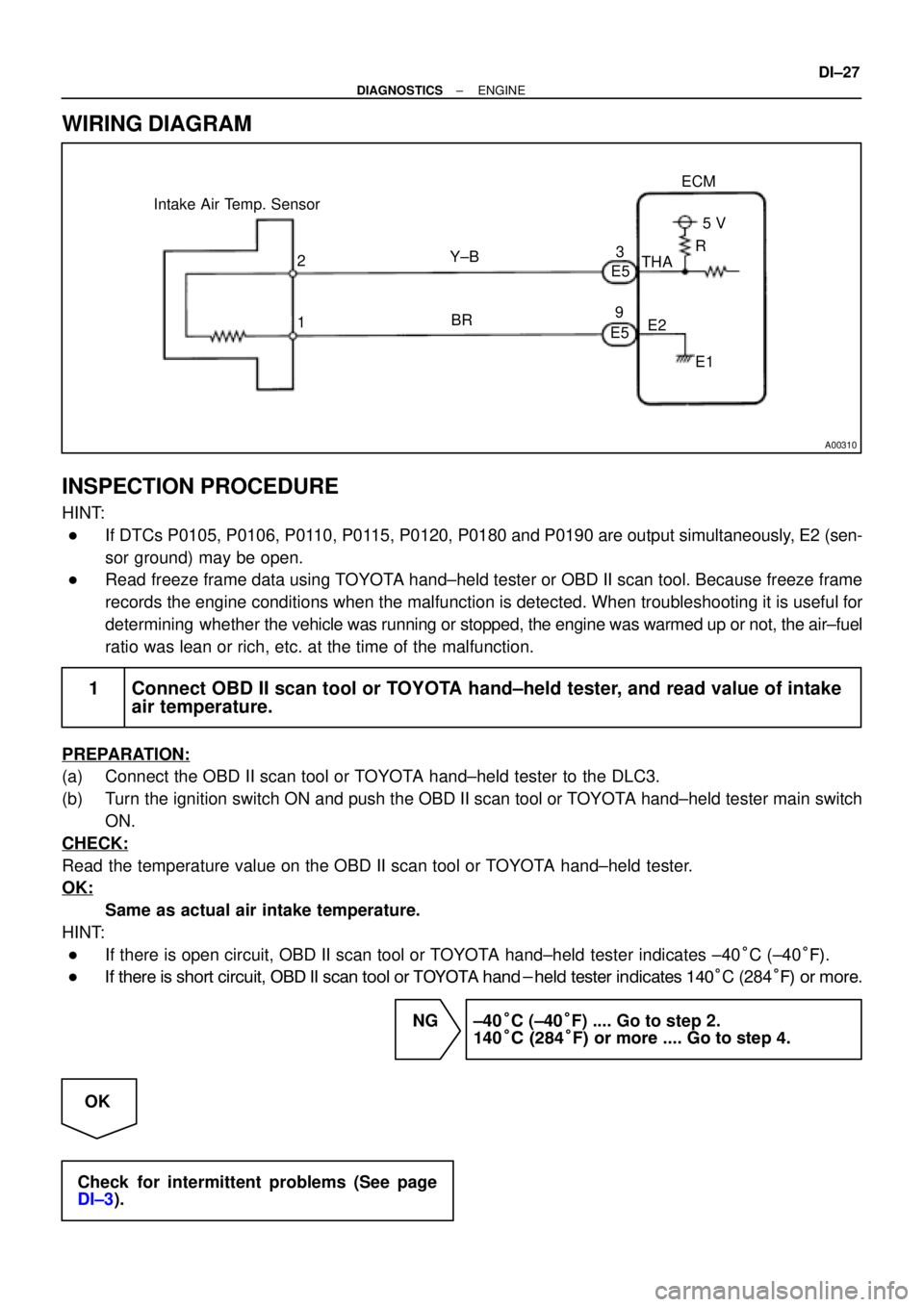
A00310
Intake Air Temp. Sensor
E5
E53
9ECM
5 V
THA
E2
E1 R
Y±B
BR 2
1
± DIAGNOSTICSENGINE
DI±27
WIRING DIAGRAM
INSPECTION PROCEDURE
HINT:
�If DTCs P0105, P0106, P0110, P0115, P0120, P0180 and P0190 are output simultaneously, E2 (sen-
sor ground) may be open.
�Read freeze frame data using TOYOTA hand±held tester or OBD II scan tool. Because freeze frame
records the engine conditions when the malfunction is detected. When troubleshooting it is useful for
determining whether the vehicle was running or stopped, the engine was warmed up or not, the air±fuel
ratio was lean or rich, etc. at the time of the malfunction.
1 Connect OBD II scan tool or TOYOTA hand±held tester, and read value of intake
air temperature.
PREPARATION:
(a) Connect the OBD II scan tool or TOYOTA hand±held tester to the DLC3.
(b) Turn the ignition switch ON and push the OBD II scan tool or TOYOTA hand±held tester main switch
ON.
CHECK:
Read the temperature value on the OBD II scan tool or TOYOTA hand±held tester.
OK:
Same as actual air intake temperature.
HINT:
�If there is open circuit, OBD II scan tool or TOYOTA hand±held tester indicates ±40°C (±40°F).
�If there is short circuit, OBD II scan tool or TOYOTA hand-held tester indicates 140°C (284°F) or more.
NG ±40°C (±40°F) .... Go to step 2.
140°C (284°F) or more .... Go to step 4.
OK
Check for intermittent problems (See page
DI±3).
Page 2181 of 4592
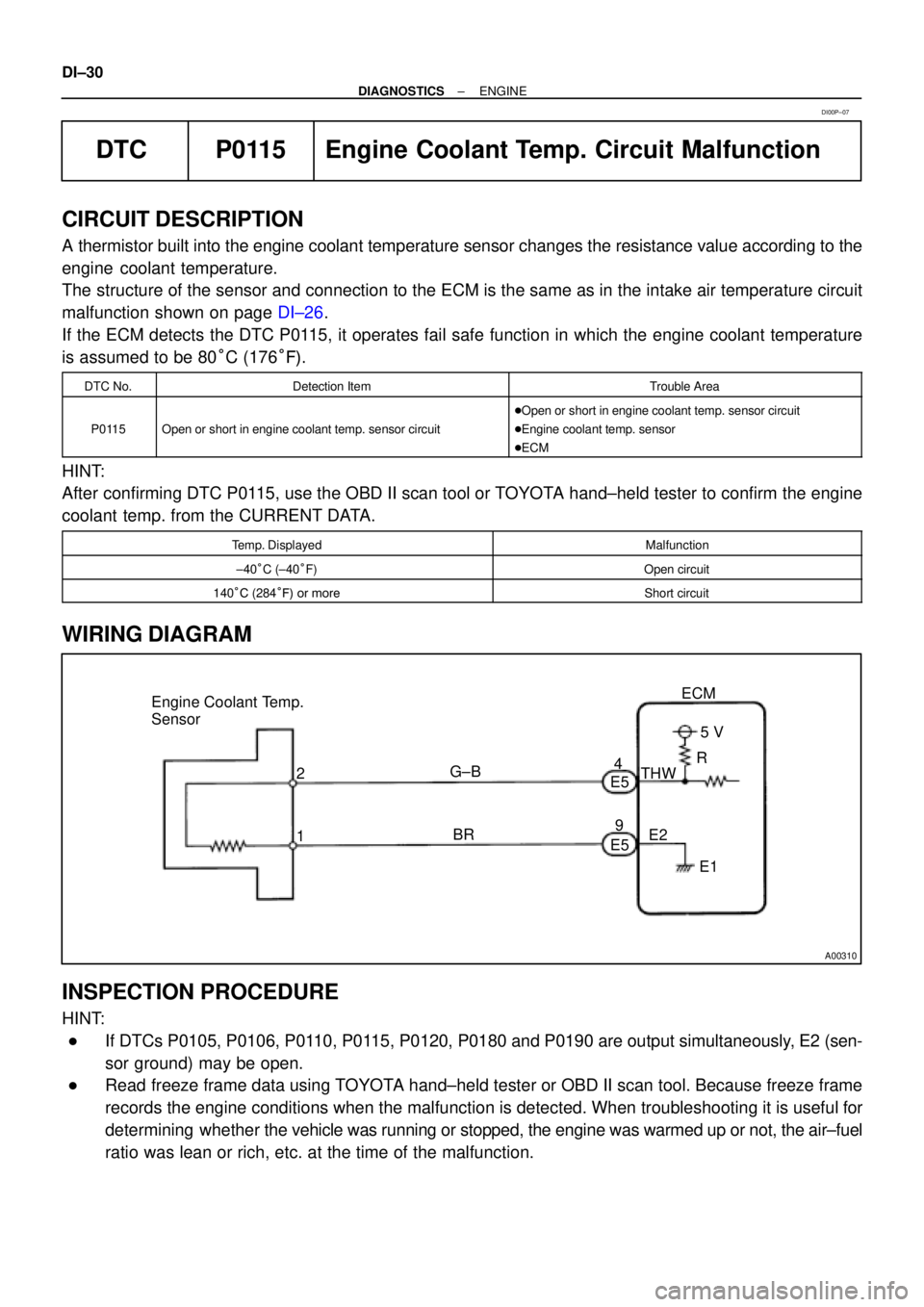
A00310
Engine Coolant Temp.
Sensor
2
1ECM
G±B
BR4
E5
E595 V
THW
E2
E1 R DI±30
± DIAGNOSTICSENGINE
DTC P0115 Engine Coolant Temp. Circuit Malfunction
CIRCUIT DESCRIPTION
A thermistor built into the engine coolant temperature sensor changes the resistance value according to the
engine coolant temperature.
The structure of the sensor and connection to the ECM is the same as in the intake air temperature circuit
malfunction shown on page DI±26.
If the ECM detects the DTC P0115, it operates fail safe function in which the engine coolant temperature
is assumed to be 80°C (176°F).
DTC No.Detection ItemTrouble Area
P0115Open or short in engine coolant temp. sensor circuit
�Open or short in engine coolant temp. sensor circuit
�Engine coolant temp. sensor
�ECM
HINT:
After confirming DTC P0115, use the OBD II scan tool or TOYOTA hand±held tester to confirm the engine
coolant temp. from the CURRENT DATA.
Temp. DisplayedMalfunction
±40°C (±40°F)Open circuit
140°C (284°F) or moreShort circuit
WIRING DIAGRAM
INSPECTION PROCEDURE
HINT:
�If DTCs P0105, P0106, P0110, P0115, P0120, P0180 and P0190 are output simultaneously, E2 (sen-
sor ground) may be open.
�Read freeze frame data using TOYOTA hand±held tester or OBD II scan tool. Because freeze frame
records the engine conditions when the malfunction is detected. When troubleshooting it is useful for
determining whether the vehicle was running or stopped, the engine was warmed up or not, the air±fuel
ratio was lean or rich, etc. at the time of the malfunction.
DI00P±07
Page 2186 of 4592
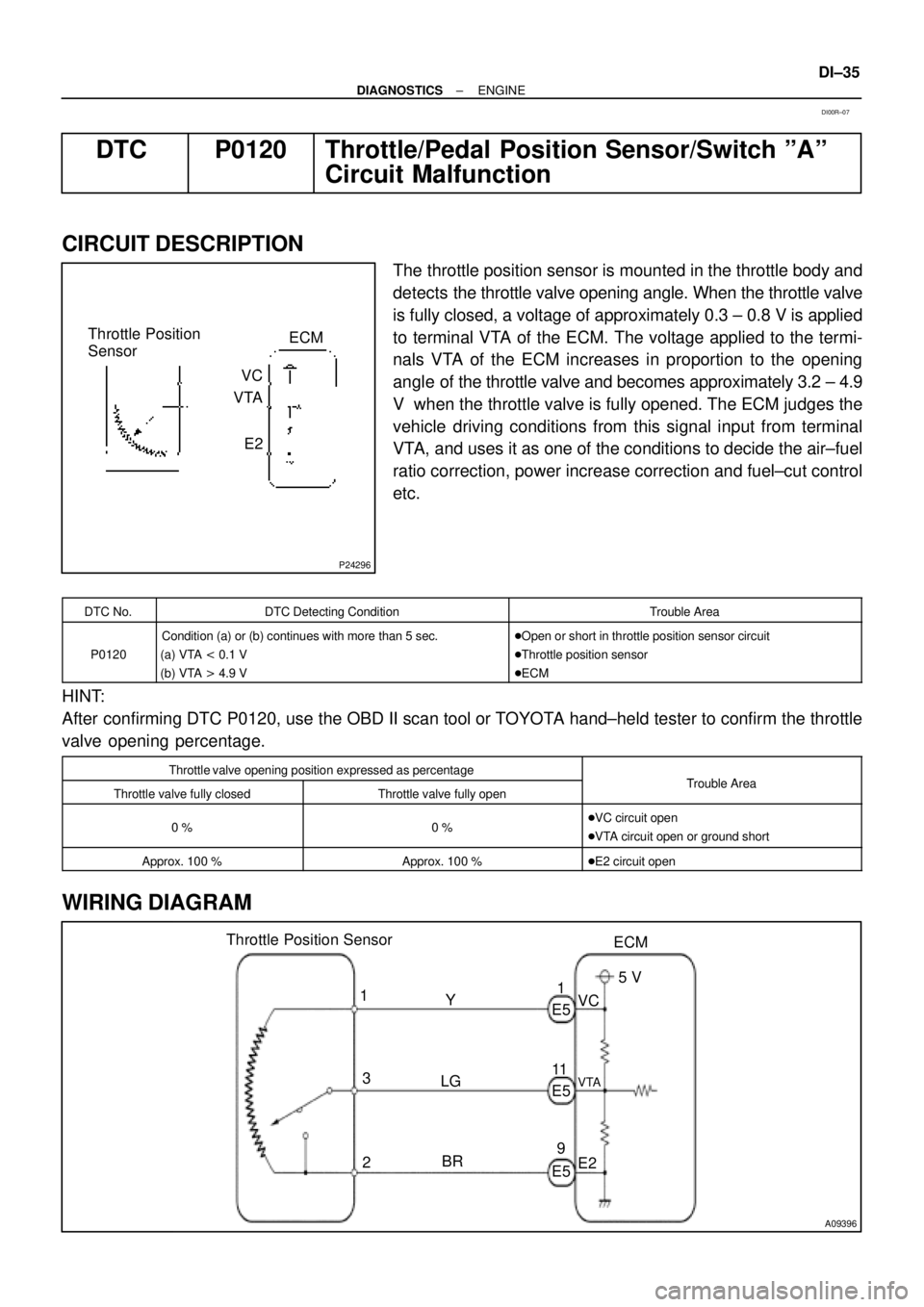
P24296
Throttle Position
Sensor
VC
VTA
E2ECM
A09396
Throttle Position Sensor
ECM
E5
E5 1
3
2Y
LG
BR1
11
9VC
VTA
E25 V
E5
± DIAGNOSTICSENGINE
DI±35
DTC P0120 Throttle/Pedal Position Sensor/Switch ºAº
Circuit Malfunction
CIRCUIT DESCRIPTION
The throttle position sensor is mounted in the throttle body and
detects the throttle valve opening angle. When the throttle valve
is fully closed, a voltage of approximately 0.3 ± 0.8 V is applied
to terminal VTA of the ECM. The voltage applied to the termi-
nals VTA of the ECM increases in proportion to the opening
angle of the throttle valve and becomes approximately 3.2 ± 4.9
V when the throttle valve is fully opened. The ECM judges the
vehicle driving conditions from this signal input from terminal
VTA, and uses it as one of the conditions to decide the air±fuel
ratio correction, power increase correction and fuel±cut control
etc.
DTC No.DTC Detecting ConditionTrouble Area
P0120
Condition (a) or (b) continues with more than 5 sec.
(a) VTA < 0.1 V
(b) VTA > 4.9 V�Open or short in throttle position sensor circuit
�Throttle position sensor
�ECM
HINT:
After confirming DTC P0120, use the OBD II scan tool or TOYOTA hand±held tester to confirm the throttle
valve opening percentage.
Throttle valve opening position expressed as percentageTblAThrottle valve fully closedThrottle valve fully openTrouble Area
0 %0 %�VC circuit open
�VTA circuit open or ground short
Approx. 100 %Approx. 100 %�E2 circuit open
WIRING DIAGRAM
DI00R±07
Page 2192 of 4592
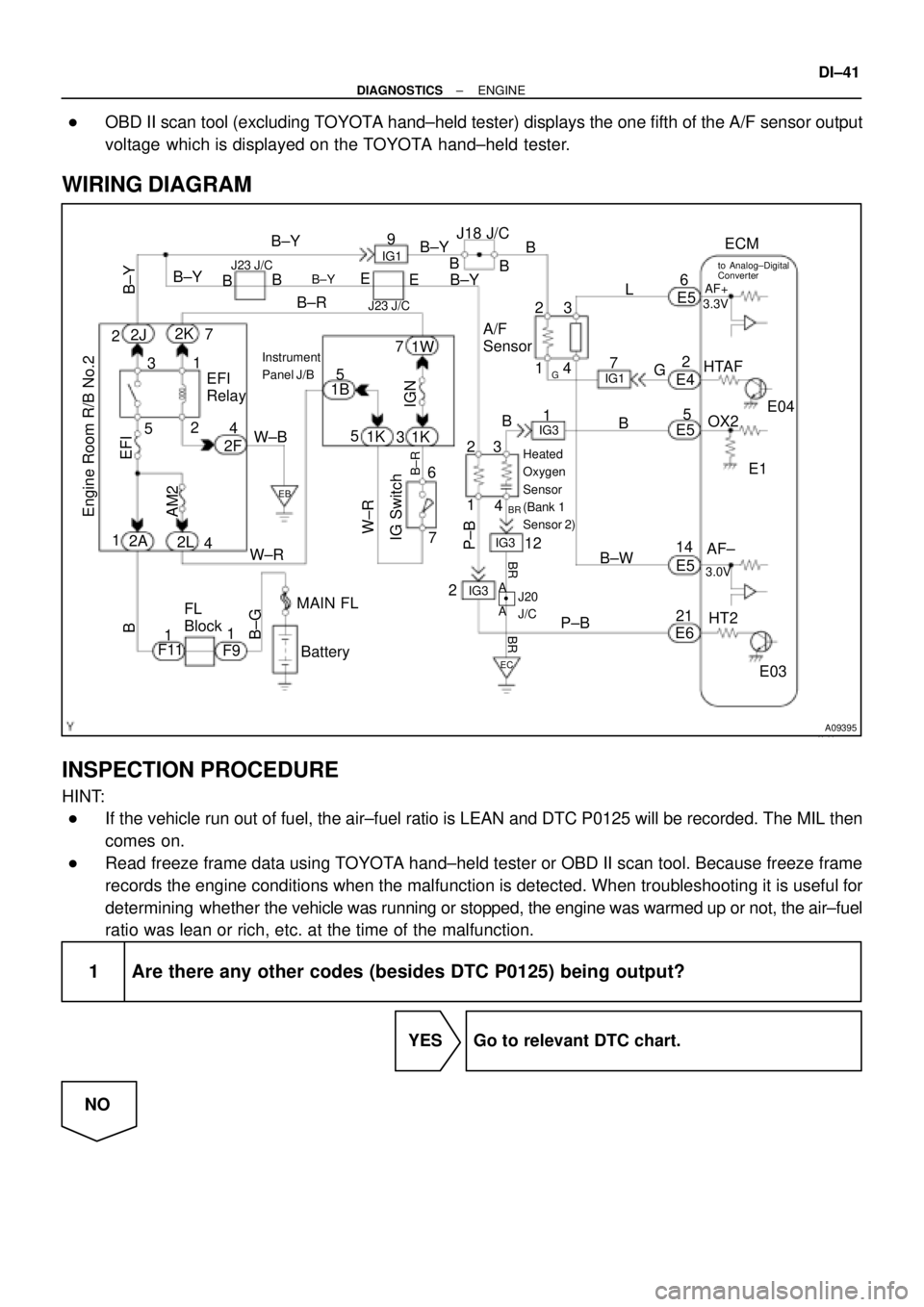
A09395
B±Y
FL
Block47
EFI
IGN
14 2
4 EFI
Relay
21
53
B±Y
3
12 B
B
1
243 9
IG1B
W±R
P±B
G
P±B 56
2
5
1K
14
HT2 21 1W
E4E5
E6E5
MAIN FLE5 1B
B 1ECM
AF+
OX2 HTAF
AF± 1K
2F
E03 E1E04 A/F
Sensor
Engine Room R/B No.2
B±YJ18 J/C
2
1
IG3IG3
IG3
EB
EC
Instrument
Panel J/B7
3 5
6
7
2L 2A
F1111
F9
B±G
Battery B±R
2K
2J
W±B
3.3V
3.0V
AM2 B
W±R
to Analog±Digital
Converter
B±Y B±Y
IG Switch
B±R
2 E
E
J23 J/C
B
BB±YL
B±W
BR
(*1)
J23 J/C
Heated
Oxygen
Sensor
(Bank 1
Sensor 2)
B
IG17G
BR
BR
J20
J/C A
A
± DIAGNOSTICSENGINE
DI±41
�
OBD II scan tool (excluding TOYOTA hand±held tester) displays the one fifth of the A/F sensor output
voltage which is displayed on the TOYOTA hand±held tester.
WIRING DIAGRAM
INSPECTION PROCEDURE
HINT:
�If the vehicle run out of fuel, the air±fuel ratio is LEAN and DTC P0125 will be recorded. The MIL then
comes on.
�Read freeze frame data using TOYOTA hand±held tester or OBD II scan tool. Because freeze frame
records the engine conditions when the malfunction is detected. When troubleshooting it is useful for
determining whether the vehicle was running or stopped, the engine was warmed up or not, the air±fuel
ratio was lean or rich, etc. at the time of the malfunction.
1 Are there any other codes (besides DTC P0125) being output?
YES Go to relevant DTC chart.
NO
Page 2196 of 4592

± DIAGNOSTICSENGINE
DI±45
DTC P0136 Oxygen Sensor Circuit Malfunction (Bank 1
Sensor 2)
CIRCUIT DESCRIPTION
Refer to DTC P0125 on page DI±40.
DTC No.DTC Detecting ConditionTrouble Area
P0136
Voltage output of heated oxygen sensor remains at 1.0 V or
more, or 0.55 V or less when vehicle is driven at 40 km/h (25
mph) or more after engine is warmed up (2 trip detection logic)�Open or short in heated oxygen sensor circuit
�Heated oxygen sensor
HINT:
Sensor 2 refers to the sensor farther away from the engine body.
WIRING DIAGRAM
Refer to DTC P0125 on page DI±40.
INSPECTION PROCEDURE
HINT:
Read freeze frame data using TOYOTA hand±held tester or OBD II scan tool. Because freeze frame records
the engine conditions when the malfunction is detected. When troubleshooting it is useful for determining
whether the vehicle was running or stopped, the engine was warmed up or not, the air±fuel ratio was lean
or rich, etc. at the time of the malfunction.
1 Are there any other codes (besides DTC P0136) being output?
YES Go to relevant DTC chart.
NO
2 Check for open and short in harness and connector between ECM and heated
oxygen sensor (See page IN±29).
NG Repair or replace harness or connector.
OK
3 Check output voltage of heated oxygen sensor.
PREPARATION:
(a) Connect the OBD II scan tool or TOYOTA hand±held tester to the DLC3.
(b) Warm up the engine to normal operating temp.
DI00Y±10
Page 2198 of 4592
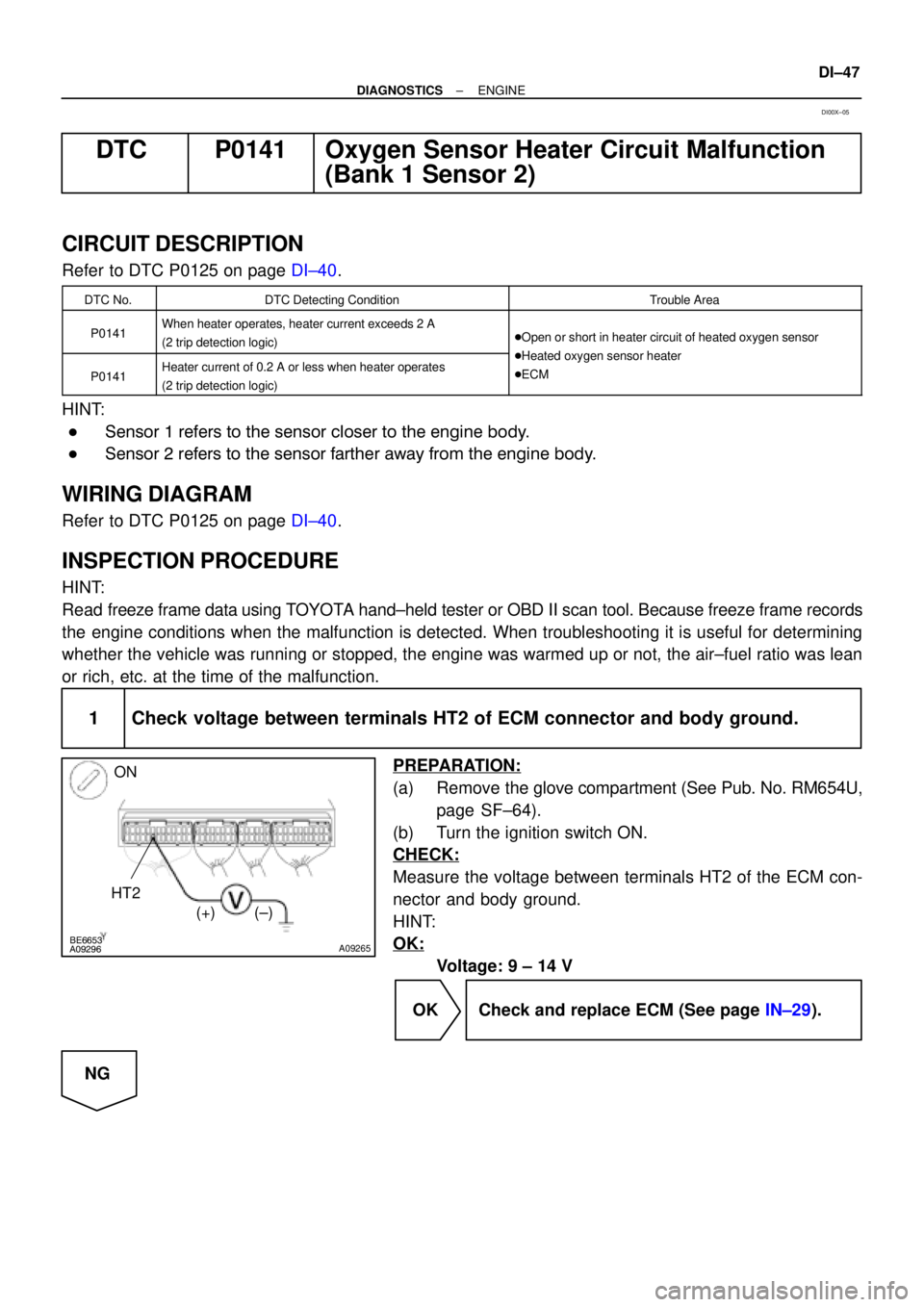
A09296BE6653A09265
ON
HT2
(±) (+)
± DIAGNOSTICSENGINE
DI±47
DTC P0141 Oxygen Sensor Heater Circuit Malfunction
(Bank 1 Sensor 2)
CIRCUIT DESCRIPTION
Refer to DTC P0125 on page DI±40.
DTC No.DTC Detecting ConditionTrouble Area
P0141When heater operates, heater current exceeds 2 A
(2 trip detection logic)�Open or short in heater circuit of heated oxygen sensor
Htd ht
P0141Heater current of 0.2 A or less when heater operates
(2 trip detection logic)�Heated oxygen sensor heater
�ECM
HINT:
�Sensor 1 refers to the sensor closer to the engine body.
�Sensor 2 refers to the sensor farther away from the engine body.
WIRING DIAGRAM
Refer to DTC P0125 on page DI±40.
INSPECTION PROCEDURE
HINT:
Read freeze frame data using TOYOTA hand±held tester or OBD II scan tool. Because freeze frame records
the engine conditions when the malfunction is detected. When troubleshooting it is useful for determining
whether the vehicle was running or stopped, the engine was warmed up or not, the air±fuel ratio was lean
or rich, etc. at the time of the malfunction.
1 Check voltage between terminals HT2 of ECM connector and body ground.
PREPARATION:
(a) Remove the glove compartment (See Pub. No. RM654U,
page SF±64).
(b) Turn the ignition switch ON.
CHECK:
Measure the voltage between terminals HT2 of the ECM con-
nector and body ground.
HINT:
OK:
Voltage: 9 ± 14 V
OK Check and replace ECM (See page IN±29).
NG
DI00X±05
Page 2201 of 4592

DI±50
± DIAGNOSTICSENGINE
�The ECM controls the voltage of AF+ and AF± terminals of ECM to the fixed voltage. Therefore, it is
impossible to confirm the A/F sensor output voltage without OBD II scan tool or TOYOTA hand±held
tester.
�OBD II scan tool (excluding TOYOTA hand±held tester) displays the one fifth of the A/F sensor output
voltage which is displayed on the TOYOTA hand±held tester.
WIRING DIAGRAM
Refer to DTC P0125 on page DI±40.
INSPECTION PROCEDURE
HINT:
Read freeze frame data using TOYOTA hand±held tester or OBD II scan tool. Because freeze frame records
the engine conditions when the malfunction is detected. When troubleshooting it is useful for determining
whether the vehicle was running or stopped, the engine was warmed up or not, the airÅfuel ratio was lean
or rich, etc. at the time of the malfunction.
1 Check air induction system (See Pub. No. RM654U, page SF±1).
NG Repair or replace.
OK
2 Check injector injection (See Pub. No. RM654U, page SF-23).
NG Replace injector.
OK
3 Check manifold absolute pressure sensor (See Pub. No. RM654U, page SF±53)
and engine coolant temperature sensor (See Pub. No. RM654U, page SF±49).
NG Repair or replace.
OK
4 Check for spark and ignition (See page IG±1).
NG Repair or replace.